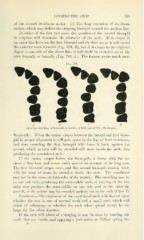Page 787 - My FlipBook
P. 787
CONSTRICTED ARCH. 785
of the second decidiious molar, (c) Too long- retention of deciduous
molars, which may deflect the erupting bicuspid toward the median line.
In either of the first two cases the position of the second bicuspid
in eruption will determine the character of the arch. If it erupts in
an exact line between the first bicuspid and the first molar it will crowd
the anterior teeth forward (Fig. 799, B), but if it erupts to the slightest
degree to one side of the direct line, it wall itself be crow^ded out of the
arch lingually or buccally (Fig. 799, A ). The former occurs much more
%^
Fig. 799.
Showing crowding of bicuspid or canine, or both, out of line (Ottolengui).
frequently. When the canine erupts between the lateral and first bicus-
pid in proper alignment it will gain space in the line of least resistance,
and thus crowding the first bicuspid will force it back against the
second, which in turn will be crowded still more inside the arch, thus
producing the constricted arch.
If the canine erupts before the bicuspids, it forms with the in-
cisors a firm base and is not easily moved on account of its long root.
The first bicuspid erupts next, and the second bicuspid, coming later,
will, for want of room, be crowded inside the arch. The conditions
may not be the same on both sides of the mouth. The crowding may be
on one side only, producing the semi-saddle arch, or varying on the two
sides may produce the semi-saddle on one side and on the other the
semi-V, or the canine may be crowded entirely out of the arch (Class 7).
Treatment.—The treatment of the constricted arch w^ill de})end upon
w^hether the case is one of normal teeth and a small arch which will
admit of enlarging, or whether the arch when spread would be too
large for the other features.
If the arch will admit of enlarging, it may be done by banding the
teeth that are inside, and applying a jack-screw or Talbot spring be-


